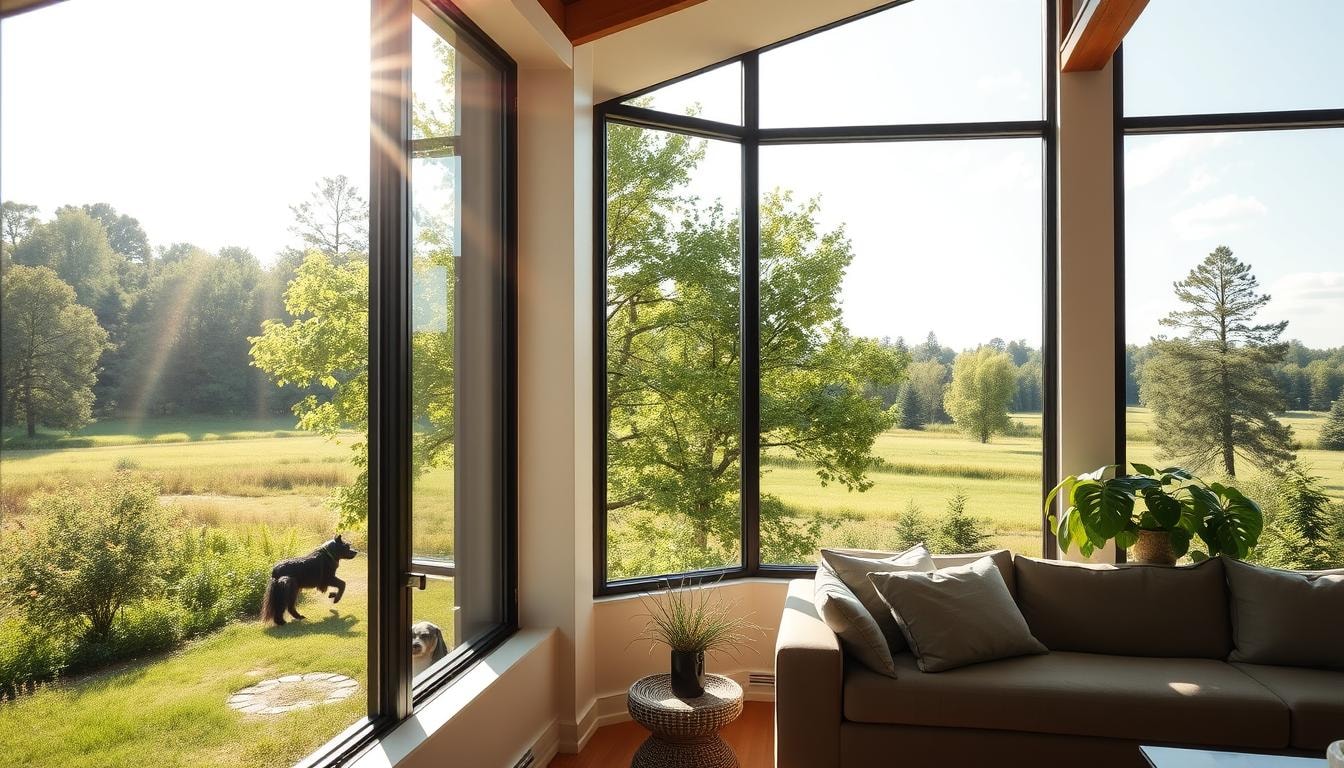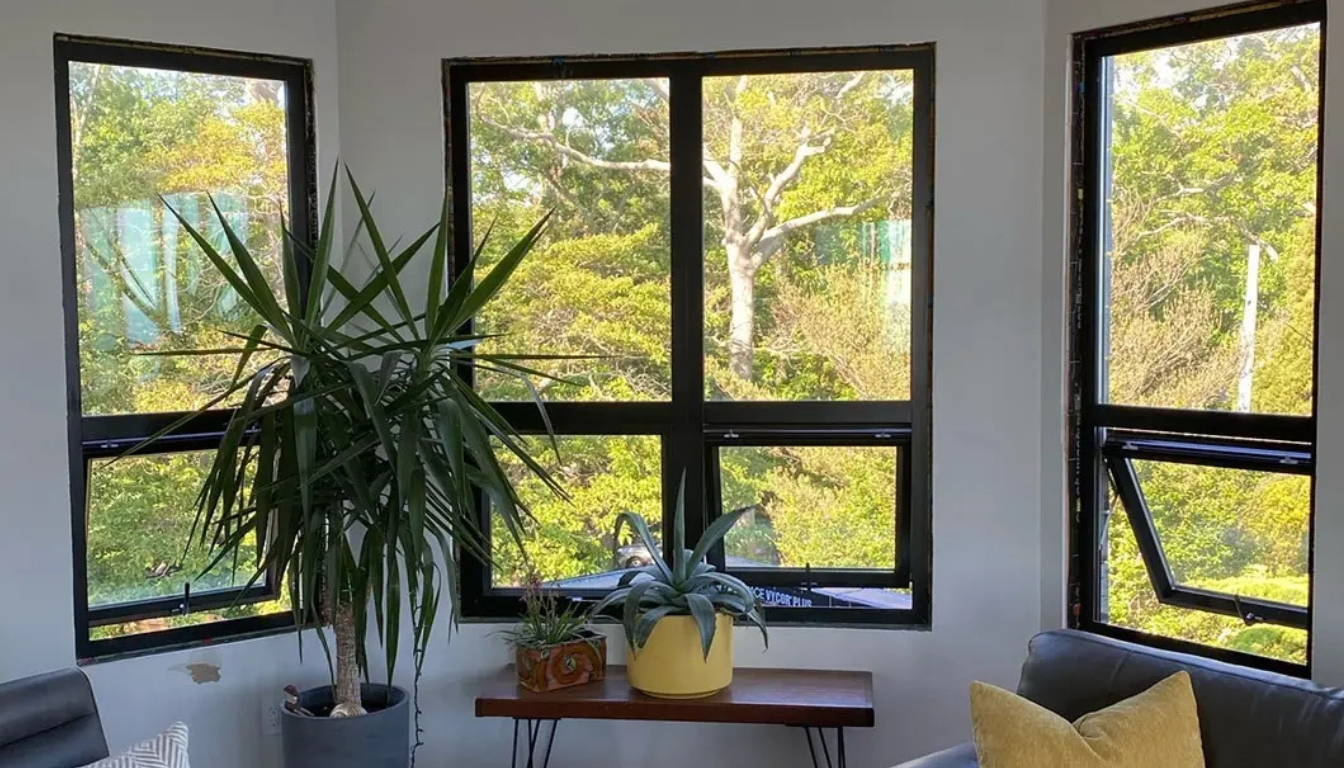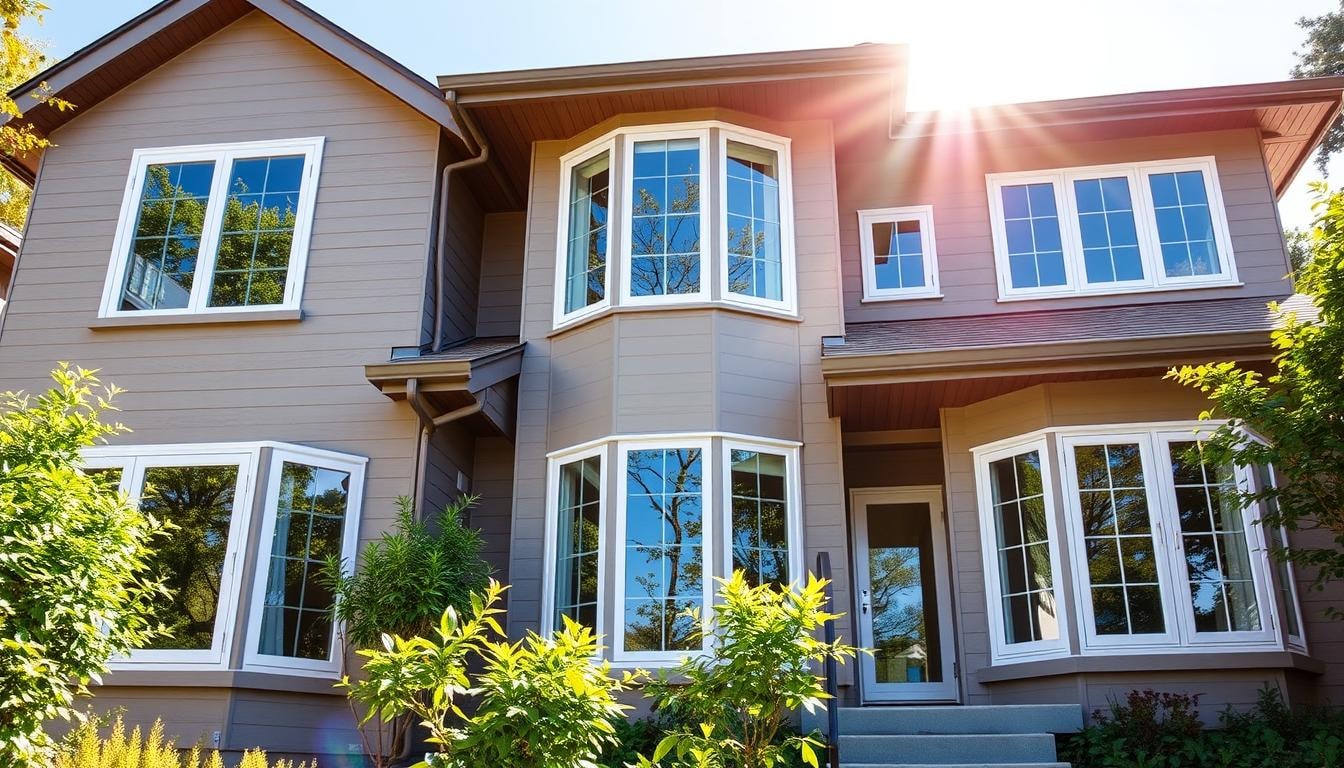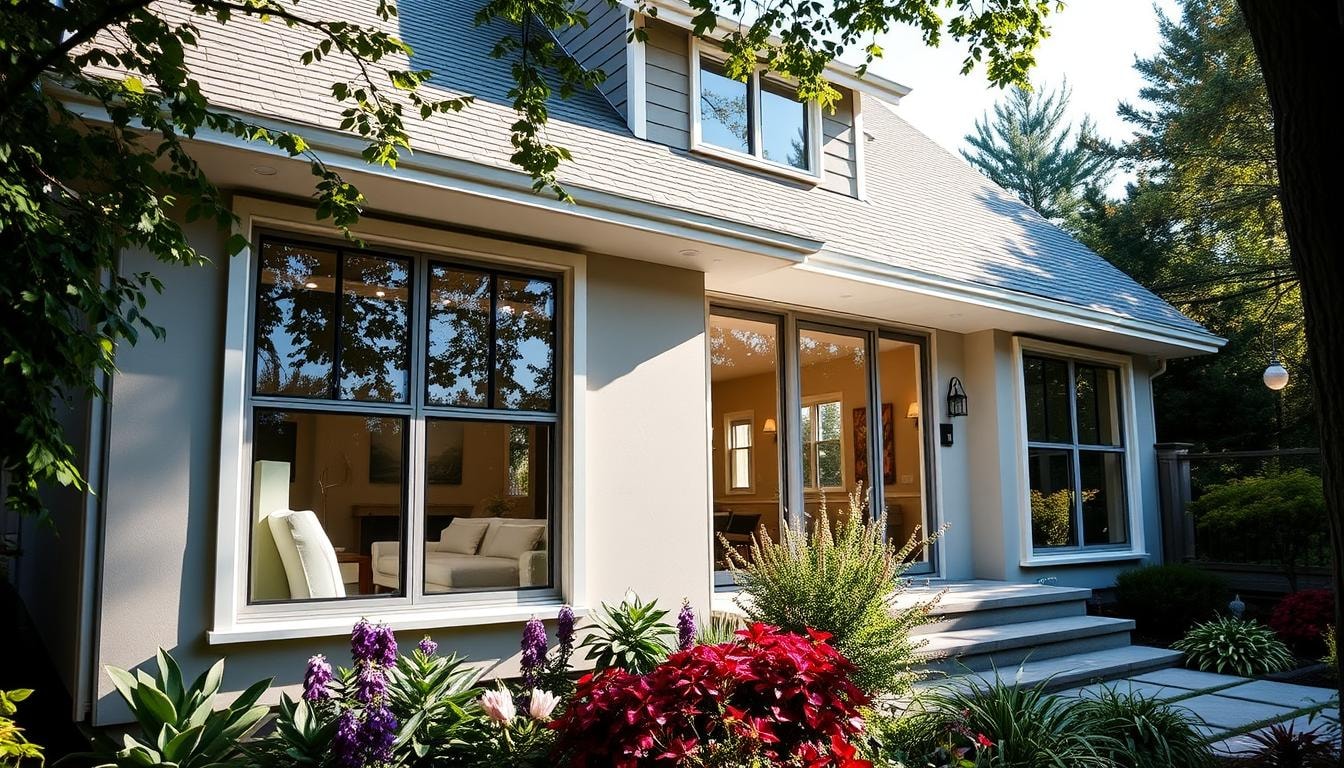
What is a Replacement Window? A Guide for Homeowners
A replacement window fits into an old frame without changing the house. It’s a smart way to make old windows better. This makes your home more energy-efficient, look better, and work better.
These windows are made to fit your current openings. This means they’re easier and cheaper to install than new frames. They make your home more comfortable, look nicer, and save energy, all with little effort.
Key Takeaways
- Replacement windows are a cost-effective way to upgrade existing windows without major structural changes.
- They can significantly improve energy efficiency, reducing heating and cooling costs.
- Professional installation is crucial for maximizing the benefits and longevity of replacement windows.
- Replacement windows come in a variety of styles, materials, and configurations to suit different home designs.
- Indicators like drafts, condensation, and difficulty in operation suggest it may be time to consider window replacement.
Understanding Replacement Windows: Basic Concepts
When you think about upgrading your windows, it’s key to know the difference. Replacement windows fit into your current frame. New construction windows include the whole frame and are for new builds or big changes.
Defining Replacement vs. New Construction Windows
Replacement windows are great for those who want to update without big changes. They fit right into your current frame, making it easier and cheaper. New construction windows are for new homes or big updates, like when your frame needs a change.
Key Components of Replacement Windows
- Sash: The moving part of the window that holds the glass
- Frame: The stationary structure that surrounds the sash
- Glazing: The glass panes that are typically double or triple-paned for improved insulation
The Purpose of Window Replacement
Replacing windows mainly boosts energy efficiency and looks, without big changes. New construction windows are best for new homes or big updates. Replacement windows are for updating old, inefficient windows in your current home.
Common Types of Replacement Windows
There are many types of replacement windows for your home. Each one has its own benefits for ventilation, looks, and function. They fit different needs and styles of homes.
The double-hung window is a favorite. It has two sashes that move up and down for good air flow. Casement windows open outwards, giving a tight seal and saving energy.
Sliding windows are modern and let in lots of light. They slide horizontally, making rooms feel bigger. Picture windows are fixed and show off views. They often work with other windows for air.
Choosing the right windows can change your home a lot. It can look better, save energy, and feel more welcoming. Knowing what each type offers helps you pick the best for you.
Window Frame Materials and Their Benefits
Choosing the right frame material for your windows is key. It affects your home’s look, feel, and value. Vinyl, wood, and fiberglass each have special benefits to think about.
Vinyl Frames and Their Advantages
Vinyl frames are a favorite for many. They’re durable, save energy, and are easy to care for. Vinyl is cheaper than wood and never needs painting, saving you money.
They also keep your home warm in winter and cool in summer. This can lower your energy bills.
Wood and Aluminum Options
Wood frames give a classic look but need more care. They need painting and staining often. On the other hand, aluminum frames are light, strong, and good for big windows.
But, aluminum can let cold and heat in. New designs help fix this problem.
Fiberglass and Composite Materials
Fiberglass and composite frames are gaining fans. They’re tough against warping and rot, perfect for damp areas. They cost more than vinyl but less than wood, offering a good balance.
When picking a frame, think about your budget, style, and energy goals. Knowing what each material offers helps you choose the best for your home.
Energy Efficiency Features in Modern Windows
Upgrading to energy-efficient windows is a smart home improvement choice. Modern windows have features that make them better at keeping your home warm or cool. They also help save money on your energy bills.
Low-E coatings are a big part of these windows. They reflect heat and let in natural light. This keeps your home at a steady temperature, which means your heating and cooling systems work less.
- Low-E coatings can improve a window’s energy efficiency by up to 55%.
- Double-pane and triple-pane windows with inert gas fills, such as argon or krypton, offer even greater insulation compared to single-pane designs.
- Triple-pane windows, in particular, provide exceptional energy efficiency, especially in colder climates, by significantly reducing heat loss.
Modern windows with Low-E coatings, multi-pane glass, and gas fills save a lot of energy. They can cut your energy bills by 7% to 15% each year. This can pay for the windows over time.
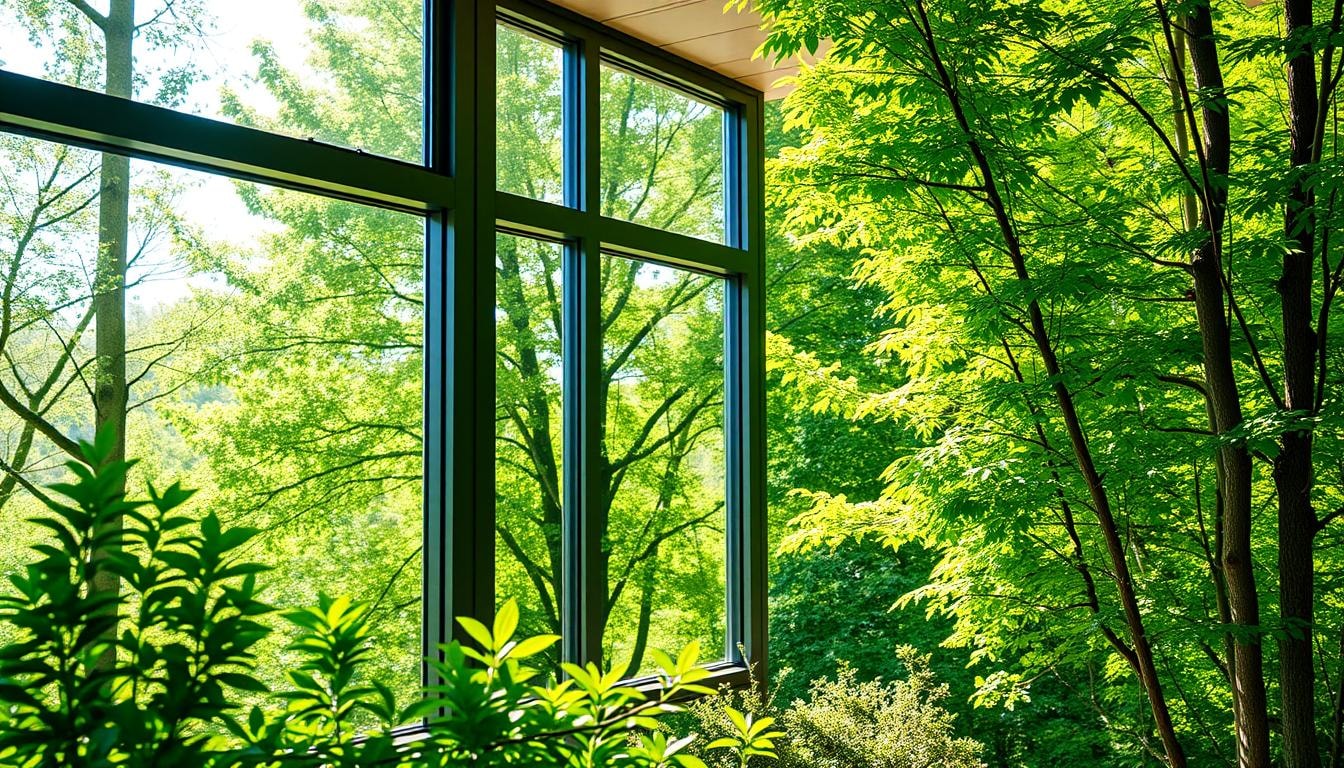
Choosing energy-efficient windows makes your home more comfortable. It also helps the planet by using less energy. With many styles to choose from, these windows are a great choice for any home.
Double-Hung and Single-Hung Windows Explained
Double-hung and single-hung windows are top picks for replacing old ones. Knowing the difference helps homeowners choose wisely. This choice affects both their needs and budget.
Double-hung windows have two sashes that move up and down. This lets you control air flow better. Single-hung windows have a fixed top sash and a moving bottom one. Both look classic and are easy to use, but they differ in some ways.
- Double-hung windows cost 10-20% more than single-hung ones because of their design.
- Double-hung windows let you control air flow better, as both sashes can open. Single-hung windows only open the bottom one.
- Cleaning double-hung windows is easier, especially on high floors, since the sashes tilt in.
- Single-hung windows might be more energy-efficient because they have fewer parts and less chance of air leaks.
When picking between double-hung and single-hung, think about the frame material too. Vinyl frames are durable and save energy. Wood frames add a classic look and keep warm or cool well. Fiberglass and composite frames are strong, last long, and handle extreme temperatures well.
The choice between double-hung and single-hung windows depends on your budget, home style, and needs. Both can save energy and look great, making them popular for window replacements.
Sliding and Casement Window Options
Homeowners often choose between sliding and casement windows. Each type has its own benefits. They match different home styles and needs.
Benefits of Sliding Windows
Sliding windows have horizontal sashes that slide on a track. They are perfect for wide openings. They also let in lots of air and are easy to keep clean.
These windows work well even when there’s something outside blocking the way. They don’t need extra space to open.
Advantages of Casement Design
Casement windows open like a door and are hinged on one side. They let in a lot of air and give clear views. This makes them great for kitchens and bathrooms.
They also seal well when closed. This helps save energy.
Choosing between sliding and casement windows depends on several things. Homeowners should think about their home’s look, energy use, and what they like. Both types can make a home look and work better.
Bay and Bow Window Configurations
Bay and bow windows are special features that stick out from a house. They add more room and views. These windows make a house look better and let in more light and air.
Bay windows have a big middle window with two smaller ones on the sides. They stick out a lot, making a room look special. Bow windows are curved with four or more windows. They look soft and fit well with many house styles.
These windows bring in lots of light and fresh air. They also make rooms bigger, perfect for reading or sitting. They’re great for living rooms and dining areas.
- Bay windows cost between $3,000 and $7,100, based on size and materials.
- Bow windows cost from $1,500 to $6,500, depending on size and materials.
- Vinyl, fiberglass, and wood are common materials. Each has its own benefits.
Choosing between bay and bow windows depends on your house, room size, and what you want to see. Bay windows are good for big rooms, making a big statement. Bow windows are better for small rooms, adding a gentle touch.
To keep these windows looking good, clean them often. Check the seals and oil the moving parts. This way, they’ll work well and look great for a long time. By picking the right windows, you can make your home more special and comfortable.
Window Glass Options and Technologies
Choosing the right glass for replacement windows is key. It affects a home’s energy use and comfort. Double-pane and triple-pane windows are two top choices, each with its own benefits.
Double and Triple Glazing
Double-pane windows have two glass layers with a gas-filled space in between. This setup cuts down on heat loss and keeps the inside temperature steady. Triple-pane windows have three layers and two gas-filled spaces. They offer even better insulation.
These windows are not just energy savers. They also block out more noise. This makes them great for places where quiet is important.
Low-E Coatings and Gas Fills
Low-E coatings are another important feature. They reflect heat but let light in. This helps windows save more energy. Gases like argon or krypton in the panes also help keep the heat in.
Together, these technologies make windows more energy-efficient. They also make homes more comfortable. This makes them a smart choice for anyone wanting to improve their home’s energy use and comfort.
Standard Window Sizes and Measurements
Knowing standard window sizes is key for easy installation. Sizes differ by type and maker, but there are common rules.
Windows usually are 24 to 48 inches wide and 36 to 72 inches tall. Many choose custom windows to match their homes exactly. Getting the rough opening right is crucial for a good fit and performance.
When measuring, remember the frame and extra features like trim or grilles. It’s best to get a pro to measure. This avoids problems and ensures a perfect fit.
Common Standard Window Sizes
- Double-Hung: Minimum height of 36 inches, maximum height of 72 inches; minimum width of 24 inches, maximum width of 48 inches.
- Picture Window: Minimum height of 12 inches, maximum height of 96 inches; minimum width of 24 inches, maximum width of 96 inches.
- Sliding Window: Minimum height of 24 inches, maximum height of 60 inches; minimum width of 36 inches, maximum width of 84 inches.
- Bay Window: Minimum height of 36 inches, maximum height of 78 inches; minimum width of 42 inches, maximum width of 128 inches.
- Casement Window: Minimum height of 29.5 inches, maximum height of 77.5 inches; minimum width of 14 inches, maximum width of 35.5 inches.
These are common sizes, but windows can be made to fit special spaces. A pro installer ensures the best fit and performance for your home.
Installation Process and Requirements
Replacing windows is a big home improvement project. It needs careful planning and execution. The steps include removing the old window and sealing the new one. Knowing what to do, whether you hire a pro or do it yourself, is key for success.
Professional Installation: Ensuring Proper Fit and Efficiency
For an easy experience, get a pro to install your windows. They make sure the windows fit right, saving energy and keeping warranties valid. They use special tools and methods to ensure the windows work well for a long time.
DIY Installation: Considerations and Potential Challenges
DIY window installation can save money but needs careful work and the right tools. You must measure the openings right, prepare the surfaces, and follow steps for a tight seal. Mistakes, like wrong measurements or bad sealing, can cost more and cause problems later.
The installation process has 12 steps, like applying flashing tape and caulking. Preparing the area well helps the job go smoothly.
Rules on DIY window permits vary by place. But, often, replacing windows in existing openings doesn’t need a permit. Always check with local authorities before starting.
Knowing the installation steps and needs helps homeowners decide to hire a pro or do it themselves. Good planning and attention to detail are vital for a successful window replacement. It will make your home more energy-efficient and look better.
Maintenance and Care Guidelines
Keeping your replacement windows in good shape is key. It helps them work well, last longer, and save energy. Taking care of your windows makes your home look better and saves money.
Cleaning Tips
It’s important to keep your windows clean. Use a soft soap and water mix to clean the frames and glass. Don’t use harsh cleaners that can harm the windows.
Use a microfiber cloth to dry and polish. This helps avoid scratches.
Seasonal Maintenance
Check your windows with the seasons to handle weather changes. Look at the weatherstripping to make sure it’s tight. This stops air and water from getting in.
Oil any parts that move, like the sash or hinges. This makes them work smoothly. Check for damage or wear, like cracks or peeling paint, and fix it right away.
Vinyl windows need little care, but wood ones might need painting or staining. By following these easy tips, your windows will last longer and work better.
Window Warranties and Protection
When you get new windows, the warranty is key. It covers defects in materials and workmanship. This means your money is safe. Most warranties last 10 to 20 years, with some going for life.
Also, if the glass gets foggy, that’s usually covered too. This is because of a common problem called glass seal failure.
The installer’s warranty is also important. It covers any mistakes in the installation. This makes sure your windows are put in right.
It’s vital to know what both warranties say. You need to follow the rules to keep them valid. Keep all your purchase and installation records safe. You might need them later.
Key Warranty Considerations
- Manufacturer warranties typically cover defects in materials and workmanship for 10 to 20 years, with some offering lifetime coverage.
- Glass seal failure, which causes fogging between panes, is usually covered for an extended period.
- Installation warranties provided by the installer cover workmanship issues and ensure proper installation.
- Proper installation and maintenance are often required to keep the warranty valid.
- Keeping records of your purchase and installation is crucial for any warranty claims.
When picking new windows, look at the warranties. This way, you know you’re covered. Knowing what your warranty says means you can relax. You’ll know who to turn to if any problems come up.
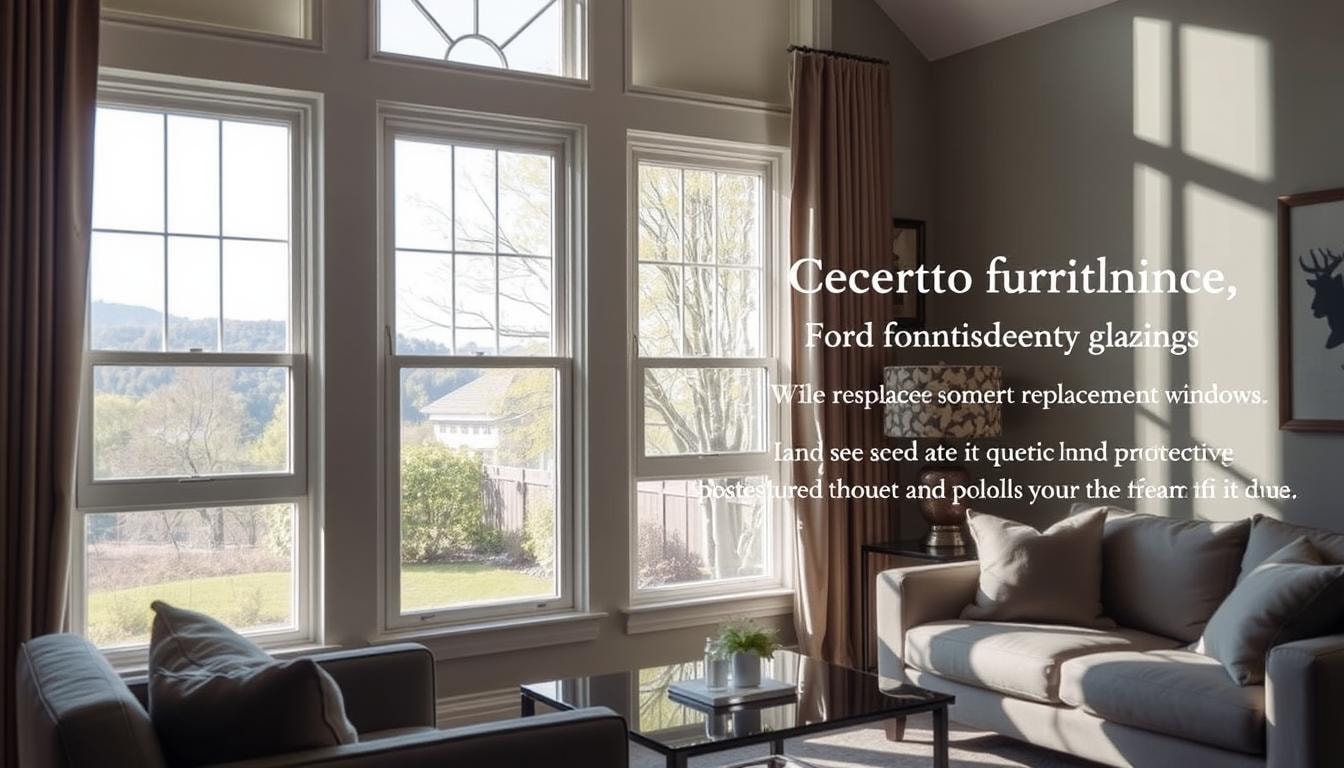
Get Expert Advice from Budget Windows
Are your existing windows costing you in energy bills and causing comfort issues in your home? Explore the benefits of replacement window installation with the experts at Budget Windows. Whether you need full frame window replacement, pocket replacement windows, or want to discuss new construction and replacement options, our team has the knowledge and experience to guide you.
From evaluating your current window condition to recommending the best replacement types that fit your home’s style and your budget, we’re here to make your window and door upgrade project a success. Schedule a free consultation today and let us help you improve your home’s energy efficiency, curb appeal, and overall comfort through professional installation methods tailored to your needs.
Don’t let old, inefficient windows impact your interior, exterior siding, or wall system – contact Budget Windows and let us handle your window and door replacement from start to finish.
Conclusion
Replacement windows are a great choice for homeowners. They help save energy, make homes more comfortable, and increase property value. These windows are a smart way to update old or inefficient windows without big changes to the house.
Choosing the right window type, material, and features is key. Homeowners can get better insulation, less upkeep, and a nicer look. This makes their homes more comfortable and attractive.
Replacing windows can be a smart long-term choice. Energy-saving windows cut down on heating and cooling costs. They also last longer and need less care, saving time and effort.
Deciding to replace windows should be a careful thought. It’s important to consider the home’s needs, budget, and goals. Talking to trusted window experts can help make the right choice. This ensures a smooth installation and the most benefits from new windows.
By focusing on energy savings, home improvement, and happiness, homeowners can make their homes better. They will enjoy a more comfortable, efficient, and beautiful space for many years.
FAQs
What is the key difference between replacement windows and new construction windows?
Replacement windows fit into your existing window frame, while new construction windows require replacing the entire frame. Replacement windows are a more cost-effective option when you want to upgrade without major structural changes to your home.
What are the common types of replacement windows available?
The most common types of replacement windows include double-hung, casement, sliding, and picture windows. Each style offers different benefits in terms of ventilation, energy efficiency, and aesthetic appeal to suit various home designs.
How do I know when it’s time to consider replacing my windows?
Signs that it may be time for window replacement include drafts, difficulty opening/closing the windows, excessive condensation, and if your current windows are in generally poor shape. Older, inefficient windows can significantly impact your home’s energy usage and comfort.
What are the key factors to consider when choosing replacement window materials?
The most common frame materials for replacement windows are vinyl, wood, and fiberglass/composite. Each has unique advantages – vinyl is low-maintenance and energy-efficient, wood provides a classic look, and fiberglass/composite is durable and weather-resistant.
What is the process for properly installing replacement windows?
Professional installation is highly recommended to ensure a proper fit and maximize the benefits of replacement windows. The process involves carefully measuring the existing window openings, preparing the surfaces, properly sealing the new windows, and disposing of the old windows. Proper installation is crucial for energy efficiency and long-term performance.





